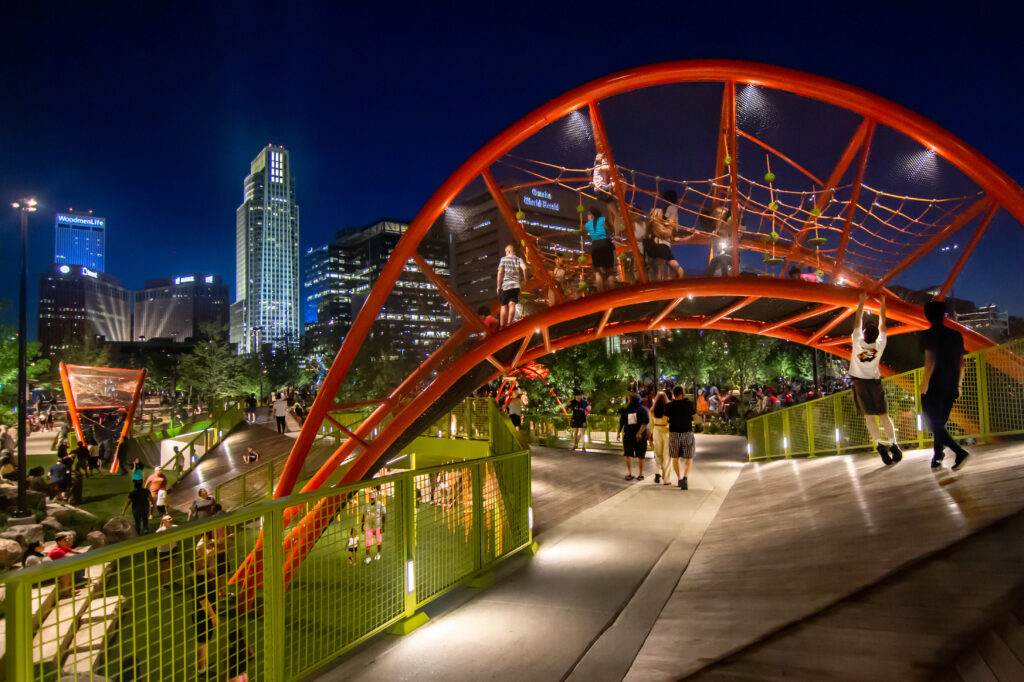“Everybody should be able to go outside and spend time together,” says Joshua Spitzig, lighting designer with Atelier Ten. “On any given night at Gene Leahy Mall you see people of all ages—families, groups of friends, crowds of kids, couples on dates—just enjoying the world.” The 14.8-acre Gene Leahy Mall (GLM) in Nebraska was reimagined as part of The Omaha River Front Revitalization Project—an approximately $325 million initiative aimed at reviving a total of 72 acres of downtown parkland along the Missouri River, transforming three underutilized parks into attractive leisure areas. Work at GLM began in 2019 and is the first of the parks to open to the public, with the second and third parks set to open in the third quarter of 2023.
Lighting designers from Atelier Ten, landscape architects from OJB, and architects from Gensler worked to breathe a second life into the beloved outdoor mall in a nearly complete overhaul of the entire area. Renovations included the removal of a street that formerly crossed the park; additional lighting along bioswales; additions such as a color-changing performance space, art sculptures, and a nearly 200-ft long structure known as the “community swings.” Though the lighting team created a special scheme inspired by the plant life and sky in Omaha, their top priority was to provide a sense of safety after dark.
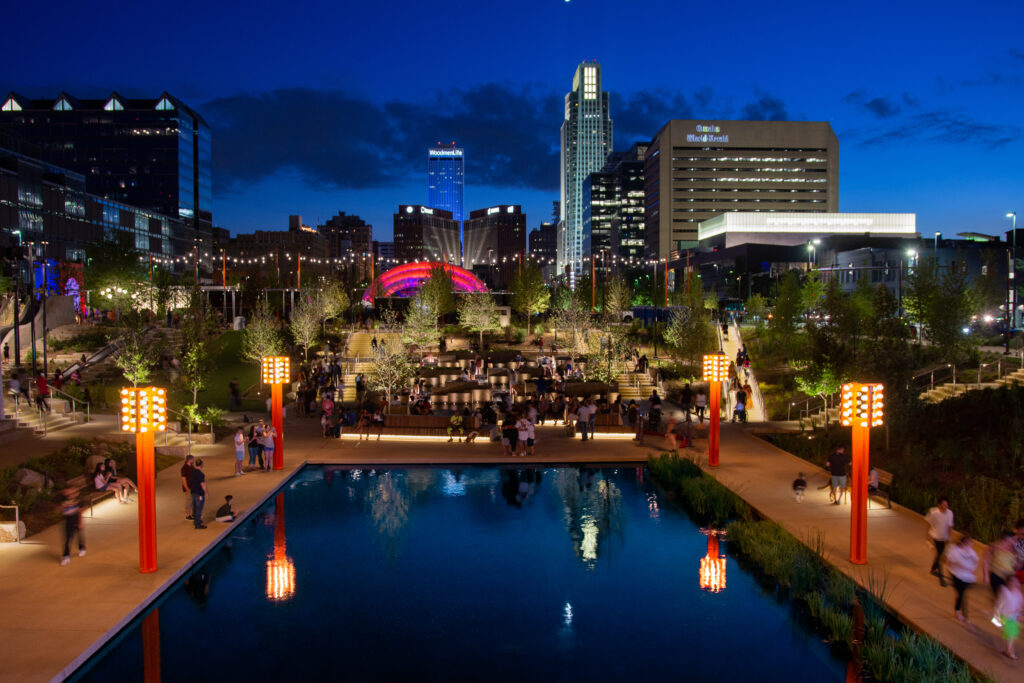
Changing preconceived notions about the project was a major hurdle. “It was really important to completely transform the visual identity of the space after dark. As a result, the light levels are probably higher overall than we would have otherwise used,” says Spitzig. To transform the park’s visual identity, the team did not simply use traditional standards, recommendations and footcandle levels. Instead, they designed the space from the perspective of a pedestrian and implemented new lighting safety measures that allowed for improved vision in the dark. “A lot of times it is easy to design outdoor lighting just based on the photometric plan and move on, but sometimes I think that is actually focusing on the wrong things. For example, many post-top fixtures are flat full cut-off fixtures with wide optics—which are perfect for roadway lighting where the roof of a car shields your eyes—but they are not so great for pedestrians. In these circumstances, human pupils close down and night vision is limited—which cancels out the light being thrown on the ground.”
Designers worked with a long list of manufacturers including Acclaim, ANP Lighting, B-K Lighting, Erco, Luminii, Selux, USAI, Vista, Wagner and more to either build or modify fixtures to meet the park’s specific safety needs. For example, Selux helped the team reimagine post-top fixtures with special optics to reduce glare. Spitzig says that although their post-top design plan makes for the occasional uneven light pattern on the ground, keeping light from people’s eyes allows them to see past the area of the park they are moving through with greater ease, thus, increasing their after-dark navigation.
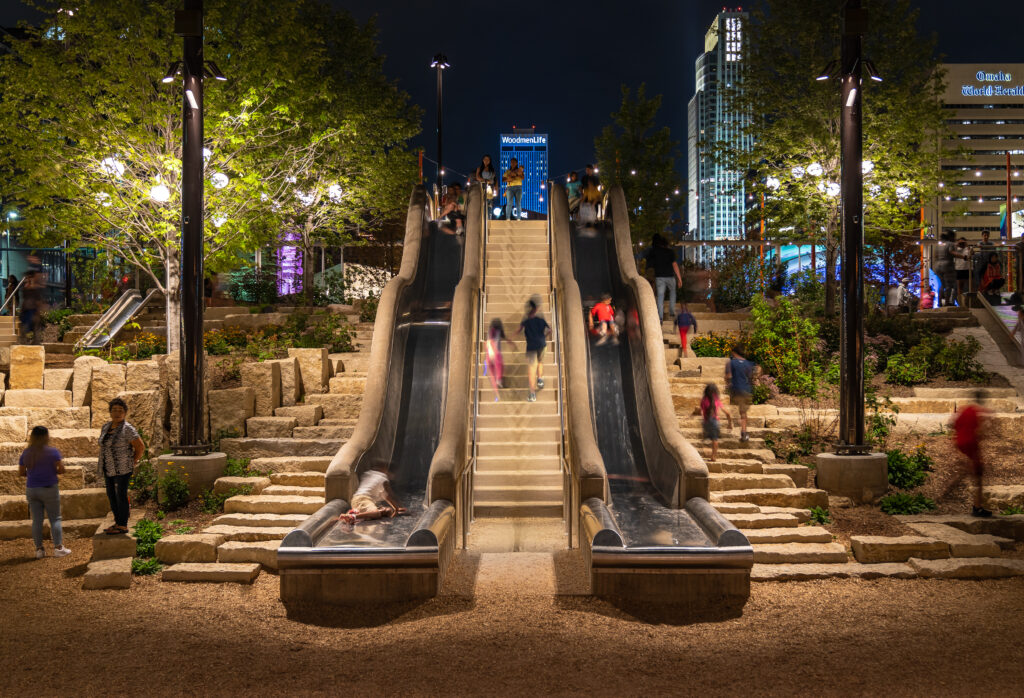
Another safety measure is a series of security floodlights with remote motion sensors strategically placed around the park, especially around popular steel slides, to alert the security team of peoples’ presence and discourage loitering after closing time.
Vandal and weather-resistant fixtures were key to ensuring the longevity of the park. The team worked with Apogee to make a custom enclosure extrusion for a flexible linear strip light that would usually be pressure fit into a channel, to prevent vandals from being able to remove it. Electricians then installed the fixture and custom extrusion with tamper-resistant screws, making the product difficult for the average person to damage. “In order to get enough of this [fixture] so that we could meet the minimum footage we designed the extrusion so that it could be used vertically, mounted against a surface and aiming down, or rotated around and mounted so that the light beam is tilted at 45 deg, so it can be used to throw light from under benches,” says Spitzig.
To accommodate a Great Plains winter, the design team specified an IP68 rating for anything within 3 ft of the ground, “even if it’s not actually under water or underground. There could be long periods when lights are sitting in snow banks or covered in ice”says Spitzig. The team chose luminaires with high-impact resistance for all fixtures within 8 ft of the ground—a consideration made with lawn mowers, snow blowers and other equipment in mind.
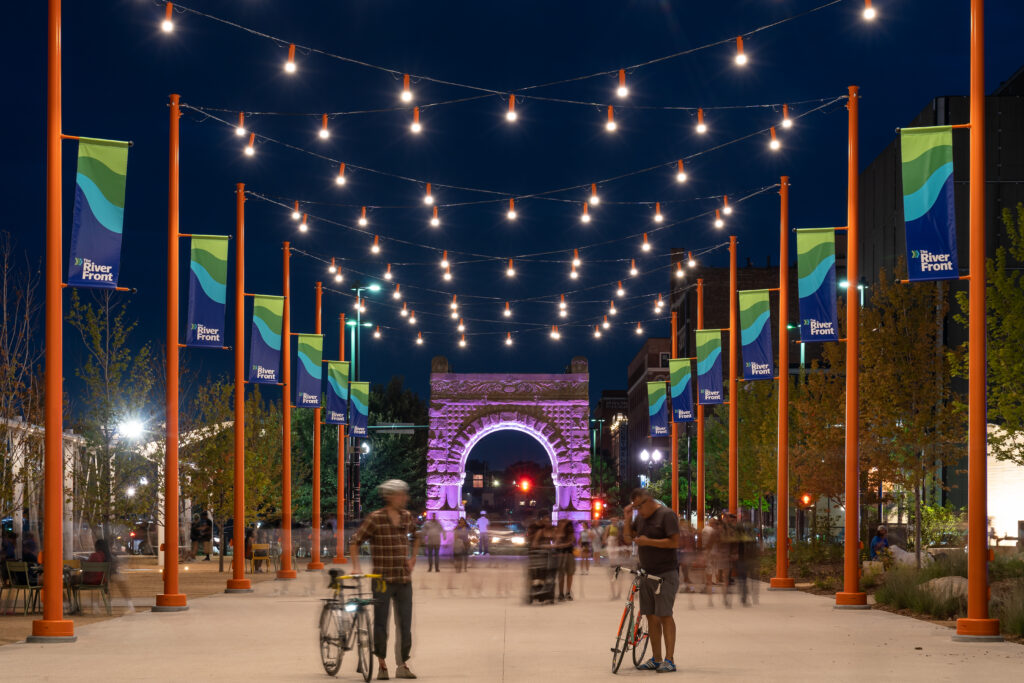
Of course, the design for the outdoor mall isn’t all serious. Parks are made for fun and games, peace and respite, culture and celebration—and the design reflects those themes from its eye-catching artwork to its color-changing LEDs. Though one cohesive park, GLM transitions from higher-energy amenities on the west side to lower-energy amenities on the east side.
In the west side, guests can visit the original two-story slides scaled for adults and children. “These are beloved in Omaha. Any time we talked to someone before the park opened and we explained we were working on a renovation, the first question was always ‘Are you keeping the slides?’ Every time I go, there is a line of kids and adults waiting to do down,” says Spitzig.
Anchoring the east side of the GLM, is a dog park for visitors’ furry friends amidst pathways that encourage ambling. While the same fixtures are used throughout the project for a unified aesthetic, designers implemented 40% fewer fixtures/less wattage per sq ft in the east side than the west side to reflect the park’s energy shift. Guests can also find large canopies, a sculpture garden, picnic tables, a boat cove—and even more—with a few color-programmable focal points: a historic arch and a prairie-wagon-inspired Performance Pavilion. Built from façades of buildings that were demolished for the creation of the original iteration of the park in the ‘70s, the stone arch was kept as a monument to the city’s history. In the current renovation the arch is lit with scenes inspired by surrounding, seasonal plant life. The summer preset mirrors the Ox-Eye Sunflower; autumn, the Fire Dogwood; winter, the Walker’s Low Catmint; and spring, the Little Bluestem.
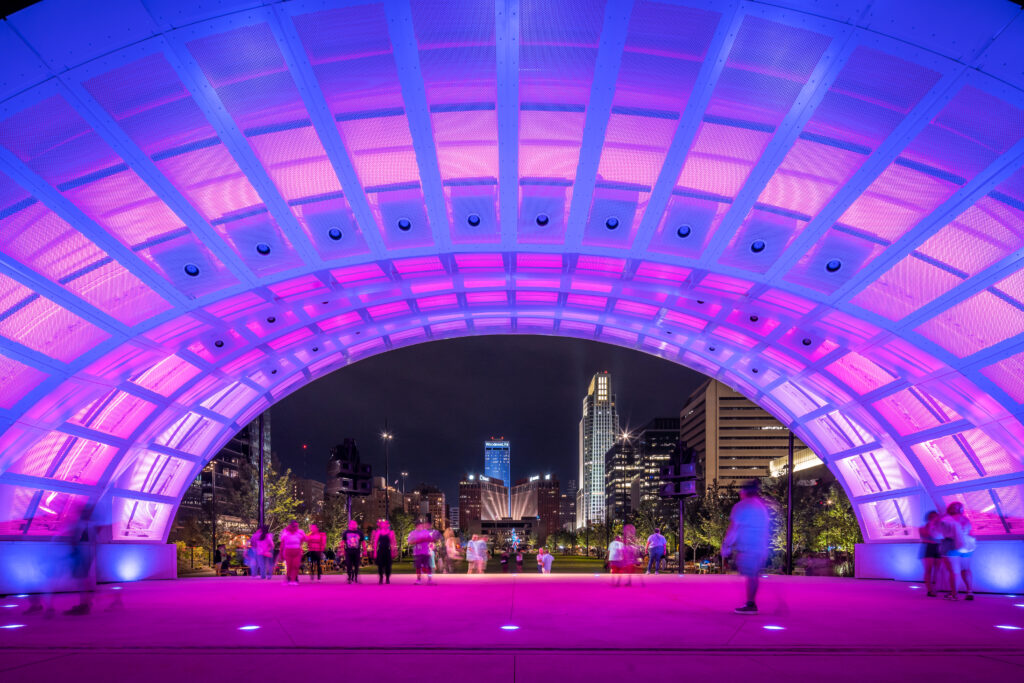
Lighting at the Performance Pavilion is inspired by the Nebraska sky. “There is Summer Sunrise, Autumn Sunset, Winter Twilight and Spring Storm. We gathered a pile of photos of the actual Nebraska sky by local photographers and picked some for inspiration for the programming of the colors. They will change for holidays, too, but the standard day-to-day programming changes with the season,” says Spitzig. Built with room for flexibility, the ETC Paradigm control system will change the preset colors automatically on the first of specific months to reflect the changing of the seasons. However, park owners can choose to manually trigger separate colors based on what is happening in the community in real time.
“Designing the lighting for parks requires a little bit of fortune telling,” says Spitzig. “Unlike buildings, parks are spaces that are literally alive and growing constantly. Every year is a little different, every season; sometimes every day is a little different. Trees lose leaves and grow them again. Understory plants change color and get thicker. Designers are lighting something that doesn’t stop when construction ends—it’s just starting. So, teams have to design a lighting system that can evolve and grow along with the space—it is something that I find really fun about working with parks.”
THE DESIGNERS
- Chad Groshart, Member IES, IALD, LEED AP BD+C, WELL Faculty, is director of lighting at Atelier Ten.
- Joshua Spitzig, Member IES, IALD, is the New York practice leader at Atelier Ten and was the lead lighting designer on the project.
- Nick DeSordi was formerly a lighting designer with Atelier Ten.


